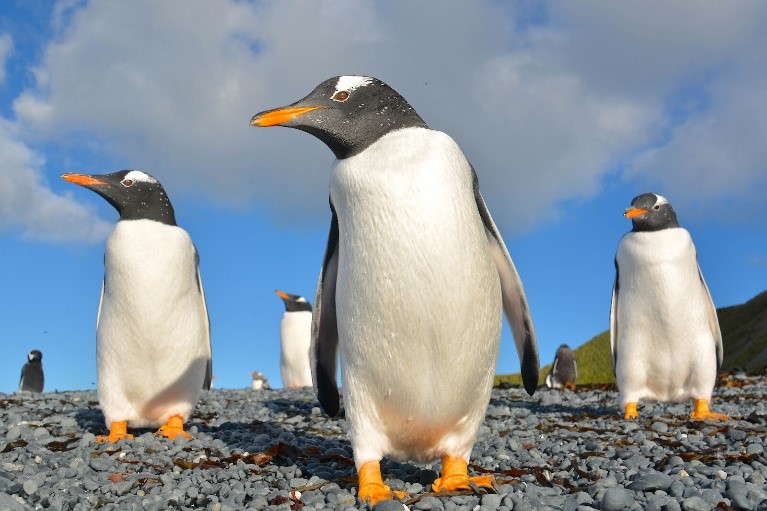Description

Disclaimer: Copyright infringement not intended.
Context
- A photographer has spotted an extremely rare all-white penguin in Chilean Antarctica.
- The penguin spotted at the Gabrial Gonzalez Videla Base is a female of the Gentoo species, which typically has black feathers with a few whites.
Gentoo Penguin
- Scientific Name: Pygoscelis papua
- Distribution: Gentoo penguins are found in sub-Antarctic and Antarctic regions, including the Falkland Islands, South Georgia, and the Antarctic Peninsula.
Physical Characteristics:
- Size: Gentoo penguins are the third-largest penguin species, reaching a height of about 30 inches (76 cm).
- Coloration: They have a distinct appearance with a white patch above the eye, a black head, a white belly, and orange-red bills and feet.
- Feathers: Gentoos have a streamlined body with waterproof feathers for efficient swimming.
Behavior and Habitat:
- Colonial Nesting: Gentoo penguins are known for forming large colonies during the breeding season, with nests constructed from stones, grass, and feathers.
- Aquatic Life: Gentoos are excellent swimmers and divers, feeding on fish, krill, and squid. They are capable of reaching speeds of up to 36 km/h (22 mph) underwater.

Reproduction:
- Breeding Season: Gentoo penguins typically breed during the austral summer, with nesting sites often located on ice-free areas.
- Egg Incubation: Both male and female gentoos take turns incubating the eggs, which usually hatch after around 34 to 36 days.
Conservation Status:
- IUCN Status: Gentoo penguins are classified as "Least Concern" by the International Union for Conservation of Nature (IUCN).
- Threats: Climate change, overfishing, and disturbance at breeding sites are key threats to gentoo penguin populations.
Unique Features:
- Vocalizations: Gentoos are known for their loud, trumpeting calls, which are part of their communication during mating rituals and nesting activities.
- Sliding Behavior: Gentoos are often observed sliding on their bellies over ice and snow, a behavior that is both playful and efficient for movement.
Human Interaction:
- Tourism: Gentoo penguins are a popular attraction for tourists visiting Antarctic and sub-Antarctic regions, with controlled tourism activities to minimize disturbances.
- Research: Scientific research on gentoo penguins provides insights into their behavior, physiology, and responses to environmental changes.
Adaptations to the Environment:
- Thermoregulation: Gentoos have a gland near their eyes that helps in the removal of excess salt, and their feathers provide insulation against the cold Antarctic waters.

Comparison with Other Penguin Species:
- Chinstrap and Adélie Penguins: Gentoo penguins share their habitat with other species like chinstrap and Adélie penguins but can be distinguished by their specific markings and behaviors.
Conservation Efforts:
- Research and Monitoring: Conservation efforts involve ongoing research to monitor population trends, nesting behaviors, and responses to environmental changes.
- Protected Areas: Establishing and maintaining protected areas to minimize human disturbances during critical breeding and molting seasons.
In conclusion, the Gentoo penguin is a fascinating species adapted to the challenging Antarctic environment.
|
PRACTICE QUESTION
Consider the following statements regarding the Gentoo Penguin:
- Gentoo Penguins are native to the Arctic region, known for their adaptability to extreme cold climates.
- The Gentoo Penguin is the largest species among all penguins, with distinctive orange markings on its head.
- They primarily inhabit the Northern Hemisphere, forming the majority of the penguin population in Antarctica.
Which of the statements above is/are correct?
A) 1 only
B) 2 only
C) 1 and 3 only
D) 2 and 3 only
Answer Explanation:
The correct answer is:
B) 2 only
Explanation:
- Gentoo Penguins are native to the Arctic region, known for their adaptability to extreme cold climates.
-
- This statement is incorrect. Gentoo Penguins are not native to the Arctic; they primarily inhabit sub-Antarctic and Antarctic regions.
- The Gentoo Penguin is the largest species among all penguins, with distinctive orange markings on its head.
-
- This statement is correct. The Gentoo Penguin is indeed recognized for its size, and it is distinguishable by the white strip across its head and distinctive orange beak.
- They primarily inhabit the Northern Hemisphere, forming the majority of the penguin population in Antarctica.
-
- This statement is incorrect. Gentoo Penguins mainly inhabit the Southern Hemisphere, with a significant presence in Antarctica.
Therefore, only statement 2 is correct, making option B the correct answer.
|












